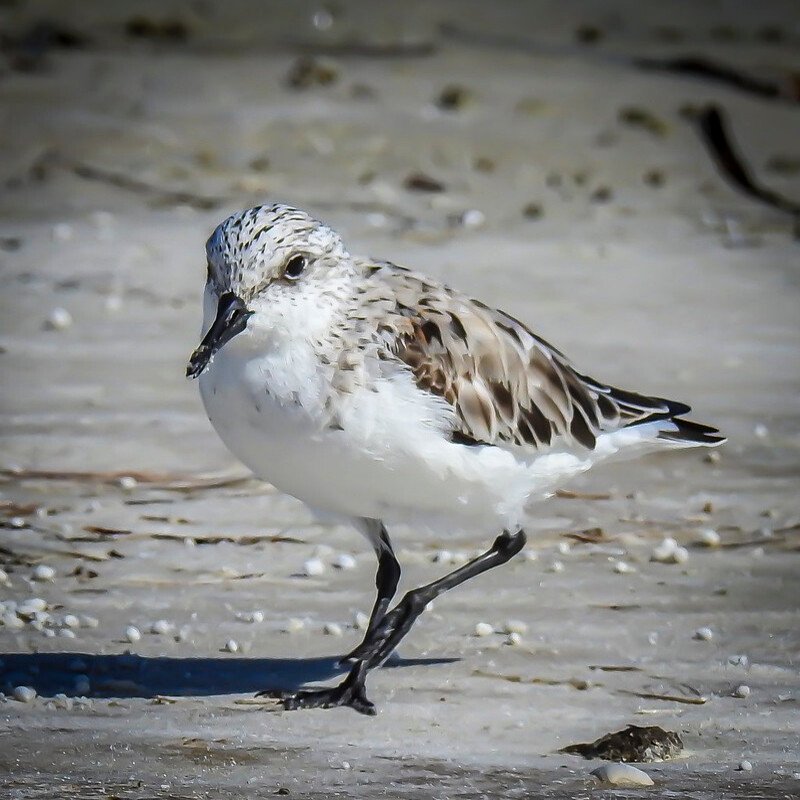The sanderling is a tiny wading bird (Calidris alba). The name stems from the Old English sand-yrling, which translates as “sand-ploughman.” The genus name derives from the Ancient Greek kalidris or skalidris, Aristotle’s word for several grey-colored waterside birds. Alba is Latin for “white.” It breeds in the circumpolar Arctic and is a long-distance migrant, wintering in South America, South Europe, Africa, and Australia. During the winter, it is extremely gregarious, forming enormous flocks on coastal mudflats or sandy beaches.
Quick Overview: Calidris Alba – Sanderling
Body size: Around 8 in (20 cm) and a weight of 110 g (3.88 oz)
Main colors: Red-Brown, White, Black
Range: Central United States
Migratory Bird: Yes
Best time of the year to see in the U.S.: March, April, May, September, October, November
Conservation Status: Least Concern
Sanderling Description
Sandpipers of this medium size have dark-spotted, rufous upper parts and breasts, white underparts, and a black bill, legs, and feet. The wings contain prominent white stripes that are visible in flight.

Size
These birds have a length of 8 in (20 cm) and a weight of 110 g (3.88 oz). Their wings could range from 14-15 in (36-38 cm).
Feeding
Sanderlings prey on aquatic and terrestrial invertebrates in their favored settings. During the mating season, insects, particularly craneflies, midges, and mosquitoes, are the predominant prey along pond or stream borders on the northern tundra.
Habitat
Sanderlings spend the breeding and winter seasons in distinct habitats. They spend the winter primarily along sandy coastlines, where they forage ahead of and behind waves in the active surf zone. Additionally, they may feed on mudflats, lagoons, and rocky intertidal areas.
Behavior
Sanderlings spend most of the year in dense flocks. Flocks can range in size from a few individuals to over 80. During the winter and migration, they congregate with other shorebirds. Individuals roost together on the ground and in the open and are relatively closely packed together during roosting. They can sprint, which is most visible when they are chasing crashing waves up and down the surf zone.
Calidris Alba Scientific Classification
- Kingdom: Animalia
- Phylum: Chordata
- Subphylum: Chelicerata
- Class: Aves
- Order: Charadriiformes
- Family: Scolopacidae
- Genus: Calidris
- Species: Calidris alba
Best time of the year to see
In the United States, the best time of year to see these birds are during the Spring season (March-May) and during the Autumn season (September – November).
Distribution of the Sanderling in the USA
Breeds on the high Arctic tundra from Alaska to Greenland and Baffin Island. Winters along the shores of Alaska, British Columbia, and Mexico, as well as from Massachusetts down to the Caribbean and southern South America.
The Sanderling can be found in the following states in the United States – Alabama, Arizona, Arkansas, California, Colorado, Connecticut, Delaware, Florida, Georgia, Hawaii, Illinois, Indiana, Iowa, Kansas, Louisiana, Maine, Maryland, Michigan, Minnesota, Missouri, Montana, Nebraska, New Hampshire, New Jersey, New Mexico, New York, North Carolina, North Dakota, Ohio, Oklahoma, Oregon, Pennsylvania, Rhode Island, South Carolina, South Dakota, Texas, Vermont, Virginia, Washington, Wisconsin, and Wyoming.
